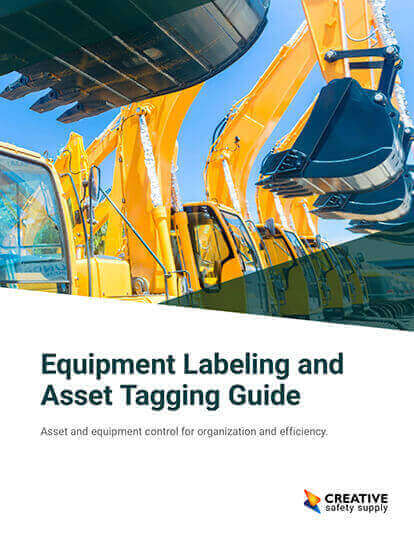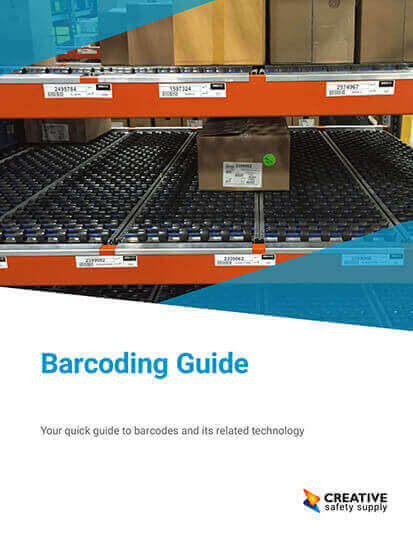
MIL-STD-129 is the United States Department of Defense Standard Practice “Military Marking for Shipment and Storage.” This important standard describes labeling requirements for any shipping containers that hold supplies and equipment for the U.S. military. It also provides identification methods to help the DOD, and its contractors, simplify and standardize the tracking of assets. The ultimate goal of MIL-STD-129 is to ensure uniformity as military items are shipped and stored anywhere in the world.
MIL-STD-129 specifically states how to format markings for each layer of packaging, and how to order these markings on labels with details such as text size and font type. There are two types of marking:
- Human readable information (HRI), which includes numbers and text.
- Machine readable information (MRI), which is typically a barcode.
Additionally, there are three levels of packaging:
- Unit containers. Also known as “unit packs,” these containers include the individual item.
- Intermediate containers. These are the outer packaging of a set of unit packs.
- Exterior containers, which are the outermost layer of packaging and contain the shipment as a whole.
What Marking is Required for the Shipment and Storage of Military Supplies?
Markings will vary according to the level of packaging. For unit containers and intermediate containers, markings must include in this order:- NATO stock number (NSN)
- Commercial and Government Entity (CAGE) code of the primary contractor
- Part number
- Item description or nomenclature
- Quantity and unit of issue (UI)
- Contract number or purchase order number
- Lot number (if applicable)
- Military preservation method and date of unit preservation
- Shelf life; includes the date the item needs to be disposed of
- Serial number(s)
- Indication of any included hazardous materials
Exterior container markings must include all of the above, as well as:
- Gross weight
- Proper shipping name (PSN) and either the North American (NA) or the United Nations (UN) HAZMAT identification number
- The Military Shipping Label (MSL)
In order to correctly mark a shipment of items, contractors should be familiar with types of marking and packaging, as well as which information must be included to inform the receivers of the contents of the container and its ultimate destination. Contractors that do not comply with these requirements will likely have their shipments rejected.
By adhering to MIL-STD-129, contractors can avoid this and other losses such as high labeling costs, delayed reimbursement, and negative supplier performance ratings. Compliance adds value to a business by improving asset tracking and ensuring a working relationship with the US military. It’s important to choose durable label solutions and ensure that all barcodes and other types of marking can withstand extreme environments so they last for the useful life of the military item.
Specifications for Barcode Data Content
Each level of packaging has its own requirements for barcode data. MIL-STD-129 requires that unit packs and intermediate containers must include identifying barcode content for:- The NATO stock number
- The Unique Item Identifier (UII) and assigned serial number(s)
Exterior container barcodes must include:
- The NATO stock number
- The contract or order number
- The CAGE code of the company maintaining the contract
- The Contract Line Item Number (CLIN)
- The contractor shipment number, when attributed
- The UII and serial number(s)
Specifications for Military Shipping Labels
Importantly, MIL-STD-129 establishes the requirements for the Military Shipping Label (MSL). These labels are used to identify which assets or supplies are within the container, who the sender is, and where the shipment is ultimately destined to go. The standard size of the label is 4 inches by 6 inches, and it should be applied on a vertical face of the container in a spot where there is minimal risk of wear or damage.The following format, a mixture of HRI and MRI markings, is required by the Department of Defense for MSLs:
- Transportation Control Number (TCN)
- Transportation Account Code (TAC)/Postage
- Ship from information: Enter the consignor Department of Defense Activity Address Code (DODAAC) or the CAGE code of the sender
- Type service
- Ship to information: Port of Entry (POE) address
- Transportation Priority (number 1, 2, 3, or 4)
- Port of Debarkation (POD) designator
- Project Code
- Ultimate Consignee/Mark for Consignee (receiver of the shipment)
- Weight (lbs)
- Required Delivery Date (RDD)
- Cube (ft)
- Charges
- Date shipped
- Foreign Military Sales (FMS) case number, if applicable
- Piece Number
- Total Pieces
- 2D PDF417 barcode
This standard has been enacted to improve productivity and accuracy, as well as enhance overall timeliness. Unless the MSL is specifically exempted in a contract between the DOD and the contractor, the MSL is always required. This is especially important in foreign military sales. Typically, the MSL will be located on the exterior container of the shipment, on palletized unit loads, and on each full truckload/railcar.
Updates to MIL-STD-129
The latest revision to this important military standard, Revision R (known as MIL-STD-129R), took place in 2014. This revision incorporated several essential changes, one of which was making radio-frequency identification (RFID) required for all shipping units. RFID is an automatic technology for identification that transfers data via radio waves in a matter of seconds. Humans don’t need to get involved and the system is simple and non-intrusive.RFID solves several challenges that used to occur within the DOD supply chain. This type of identification provides in-transit visibility that takes place in almost-real time, which improves asset management, data quality, and material maintenance. Data is accurately captured and entered into the Wide Area Workflow (WAWF), which is the DOD’s electronic invoicing and processing system. This makes it much easier for DOD contractors to get their invoices approved, and receive payment.
The most significant change MIL-STD-129R introduced, however, was the standardized use of two-dimensional PDF417 barcodes. The military is moving away from the use of linear barcodes, as these crowd the label and can’t carry data to sufficiently support the DOD’s modern automated supply chain. A single dense, machine-readable PDF417 barcode replaces the 10 linear barcodes that were previously required.
PDF417 allows automated data systems to read all information for the shipment at one time; by scanning the single PDF417 barcode that’s on the outside of the container, military staff can quickly import the information for each product inside into the WAWF, without needing to open the container. In fact, most of the data that is required to appear on the MSL is encoded in the PDF417.
This specialized barcode also has the ability to accommodate the demands of Unique Identification (UID) markings. These markings contain up to 50 characters and are too long to be represented with traditional barcodes. Currently, the military is focusing on the need to identify supplies with UIDs.
The Importance of the Unique Identifier (UID)
The Unique Identifier (UID) marks an item with character or number sequences that are globally unique. Also referred to as Item Unique Identification (IUID), these were created by the Department of Defense to provide better accountability for their assets; a specific number is assigned to each piece of equipment that is purchased or owned by the United States government. This number is marked on the asset for its useful life.A key characteristic to the UID marking is the presentation of information in a rectangular 2D barcode that is known as a data matrix code. This can be read with a digital imager and is different than the traditional string of bars and spaces people typically associate with a barcode. The distinct type of marking was established in 2004 by the Department of Defense Standard Practice 130, “Identification Marking of U.S. Military Property.” An item’s sequence must be unique to either the individual item, or to the company that manufactured it.
The purpose behind the DOD’s UID registry is to have a single location where information on everything the department owns can be stored and accessed. UIDs provide information such as purchase date, purchase price, date sent for repairs, or date taken out of commission. This in turn makes it much easier to comply with military condition tags, which describe whether equipment is serviceable, suspended, under testing, or unserviceable.
The Difference Between MIL-STD-129 and MIL-STD-130
The Department of Defense Standard Practice 130 provides directions on how to mark individual items that are produced for and sold to the DOD. Standard Practice 129 details labeling requirements for containers that hold military supplies for shipment and storage. Both of these standards ensure uniformity and make it much easier to track assets.MIL-STD-130 is most noted for its original introduction of the UID data matrix, which has been since incorporated into MIL-STD-129. Standard 130 also describes:
- Materials allowed
- Text fonts, size, and format for marking
- Rules for identifying marks on an item
- Where to apply this marking, as well as unique situations and exceptions
- Barcodes must be permanent and pass a verification process
Other markings that are non-identifying, such as “This End Up,” are covered under MIL-STD-129. There are several marking methods allowed, and most commonly contractors use a thermal transfer printer to create a polyamide or polyester label.
Together, MIL-STD-129 and MIL-STD-130 are foundational standards for many DOD contractors to refer to when it comes to the correct methods of labeling and marking U.S. military supplies. Although these labeling requirements can be quite complicated, many companies find value in successful compliance and have the ability to maintain a long-term partnership.
Additional MIL-STD-129 facts:
- MIL-STD-129 is a standard that specifies the requirements for the uniform marking of military supplies and equipment for shipment and storage. It covers the types, sizes, locations, and methods of applying markings, as well as the information to be included in the markings. Source: https://www.dla.mil/Portals/104/Documents/DLMS/Committees/DoDAAD/MIL-STD-129R.pdf
- MIL-STD-129 is applicable to all items that are procured, stocked, stored, issued, or shipped by the Department of Defense and its contractors. It also applies to items that are loaned, leased, or donated to foreign governments or international organizations. Source: https://www.dla.mil/Logistics-Operations/Packaging/
- MIL-STD-129 has four types of markings: unit container markings, intermediate container markings, exterior container markings, and military shipping label (MSL). Each type of marking provides different levels of information and identification for the items. Source: https://macpackaging.com/mil-std-129/
- MIL-STD-129 requires the use of linear bar codes and two-dimensional (2D) symbols to encode certain data elements in the markings. These data elements include the national stock number (NSN), the serial number, the contract number, the lot number, and the unique item identifier (UII). Source: https://vsc.gsa.gov/drupal/sites/default/files/internal-files/InstructionsMilitaryStandard129Compliance.pdf
- MIL-STD-129 is periodically updated to reflect the changes in technology, policy, and procedures. The latest version of the standard is MIL-STD-129R with Change 3, which was issued in September 2020. Some of the changes include the addition of the UII data element, the clarification of the RFID tag placement, and the revision of the MSL format. Source: https://www.nib.org/sites/default/files/NIBThisWeek/2016/MILSTD_129P_Chg4.pdf
Similar Articles
- Military Equipment [Condition Tags & Labeling]
- Creating an Effective Warehouse Storage Numbering System with Barcodes
- Introduction to Shipping Container Labeling
- Asset Tags: Tracking Inventory & Equipment
- A Simple Guide to Transportation Industry Labeling Strategies
- Barcode Labeling
- NFPA 855: The Installation of Stationary Energy Storage Systems
- Floor Marking for Facility Safety
- Rack Labeling


